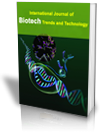Qualitative and quantitative evaluation of bioaerosol in selected public spaces
Citation
MLA Style:Shilpashree Mayachar K, Prof. Nandini N"Qualitative and quantitative evaluation of bioaerosol in selected public spaces" International Journal of Biotech Trends and Technology 10.1 (2020): 60-66.
APA Style:Shilpashree Mayachar K, Prof. Nandini N. Qualitative and quantitative evaluation of bioaerosol in selected public spaces International Journal of Biotech Trends and Technology, 10(1), 60-66.
Abstract
This study is aimed at quantitative assessment of air borne bioaerosol in public spaces. Indoor air quality is an important contributor because modern human beings spend most of their life time in indoor. Therefore the quantification of airborne bacteria and fungi in public spaces such as health centers, auditoriums, libraries, seminar halls and rest room/toilets in Bangalore university campus was carried out by following standard impaction method and reported as colony forming units per cubic meter of air (CFU/m3). The results of above study revealed that average total fungal count in health center was 1,256 CFU/m3 in air conditioned (A/c) Auditorium; it was measured as 175 CFU/m3, at in library 2523 CFU/m3 , in seminar Hall 395 CFU/m3. , in Toilets it was 1,416 CFU/m3. . The average Total bacterial bioaerosol measured at health center was of 654 CFU/m3, at air conditioned Auditorium (AC) it was 310 CFU/m3, in library 1,159 CFU/m3, in seminar hall 586 CFU/m3 and in toilet 1,438 CFU/m3 respectively. The indoor to outdoor ratio of fungal and bacterial aerosol were found to be equal to 0.005 or > 0.005. From the above study we can conclude that the bioaerosol concentration in indoor environment is comparatively less than outdoor but high enough to cause infection in indoor occupants.
References
[1] Network, G. A. (2016). “The Global Asthma Report 2018”. Auckland, New Zealand.
[2] Jindal, S. K., Aggarwal, A. N., Gupta, D., Agarwal, R., Kumar, R., Kaur, T., & Shah, B (2012). “Indian study on epidemiology of asthma, respiratory symptoms and chronic bronchitis in adults (INSEARCH)”. The International Journal of Tuberculosis and Lung
[3] Paramesh, H. (2002). “Epidemiology of asthma in India”. The Indian Journal of Pediatrics, 69(4), 309-312.
[4] U.S. Environmental Protection Agency (EPA) (2019). “Why Indoor Air Quality is Important to Schools (1994-523-217/81322)”. Retrieved from https://www.epa.gov/iaq-schools/why-indoor-air-quality-important-schools.
[5] World Health Organization (WHO, 2010). “WHO guidelines for indoor air quality: selected pollutants; WHO: Copenhagen”, Denmark
[6] Raina M.Maier., Ian L. Pepper &Charles P. Gerba (2006). “Environmental Microbiology. Elsevier Publisher” , ISBN-10:81-312-0253-4
[7] “ASTM (2014a) E1370-14 Standard guide for air sampling strategies for worker and workplace protection”. West Conshohocken, PA: ASTM International.
[8] Andersen, a (1958). “New sampler for the collection, sizing and enumeration of viable airborne particles”. Journal of Bacteriology, 76(5), 471.
[9] US Environmental Protection Agency (2000) “U.S. EPA BASE Study Standard Operating Procedure for Sampling and Characterization of Bioaerosols in Indoor Air”.EH&E Report no. 11663: Washington, DC, USA, US Environmental Protection Agency.
[10] US Environmental Protection Agency (2003) “A Standardized EPA Protocol for Characterizing Indoor Air Quality in Large Office Buildings”, Washington, DC, USA, US Environmental Protection Agency
[11] Apha, A. (2012). WEF. (2012). “Standard methods for the examination of water and wastewater”, 22.
[12] De Vos, P & Garrity, G. M (2009). “Bergey`s manual of systematic bacteriology”. Volume two 2nd Edition Springer. ISBN: 10:0-387-24145-0.
[13] Barnett, H. L & Hunter, B (1972). “Illustrated genera of imperfect fungi. Illustrated genera of imperfect fungi”. (3rd ed). ISBN: 589-24022.
[14] Ellis, M. B. (1971). “Dematiaceous hyphomycetes”. Dematiaceous hyphomycetes.ISBN:851980279
[15] Salo, P. M., Arbes Jr, S. J., Sever, M., Jaramillo, R., Cohn, R. D., London, S. J & Zeldin, D. C. (2006). “Exposure to Alternaria alternata in US homes is associated with asthma”
[16] ASHRAE Standard-55. (1992). “Thermal environment conditions for human occupancy. In American society of heating, refrigerating & air-conditioning engineers”, Inc, Atlanta, GA, USA
[17] Lian, K. S., Inangda, P. S. N., & Ramly, A. (2007). “Sources of indoor air quality problem in a new hospital in Malaysia. In The 6th International Conference on Indoor Air Quality”, Ventilation & Energy Conservation in Buildings, Sendai, Japan.
[18] Ghosh, B., Lal, H., Kushwaha, R., Hazarika, N., Srivastava, A & Jain, V. K (2013). “Estimation of bioaerosol in indoor environment in the university library of Delhi”. Sustainable Environmental Research, 23, 199-207 symptoms. Journal of Allergy and Clinical Immunology, 118(4), 892-898.
[19] Crtis, L., Lieberman, A., Stark, M., Rea, W., & Vetter, M. (2004). “Adverse health effects of indoor molds”. Journal of Nutritional & Environmental Medicine, 14(3), 261-274.
[20] Kumar, R. S. (2014). “Aerial Molds in the Campus of an Educational Institution Chennai Tamil Nadu India”. International Journal of Pharmaceutical & Biological Archive, 5(1).
[21] Lavoie, J., Marchand, G., Cloutier, Y., Hallé, S., Nadeau, S., Duchaine, C., & Pichette, G. (2015). “Evaluation of bioaerosol exposures during hospital bronchoscopy examinations”. Environmental Science: Processes & Impacts, 17(2), 288-299.
[22] Bankole, O. M. (2010). “A review of biological deterioration of library materials and possible control strategies in the tropics”. Library Review.
[23] Ohagim, P. I., Ikon, G. M., Matthew, P. C & Ohagim, G. A (2017). “Microbiological assessment of indoor air in public toilets across selected motor parks in Owerri Metropolis”, Nigeria. J Microbiol Exp, 5(6), 00166.
[24] Sivasakthivel, S., & Nandini, N. (2017). “Seasonal Variation of Airborne Viable Bacterial Pollution in Bengaluru Urban”, Karnataka, India. Environ Sci Ind J, 13(4), 145.
[25] Barberán, A., McGuire, K. L., Wolf, J. A., Jones, F. A., Wright, S. J., Turner, B. L., ... & Fierer, N. (2015). “Relating belowground microbial composition to the taxonomic, phylogenetic, and functional trait distributions of trees in a tropical forest”. Ecology Letters, 18(12), 1397-1405.
[26] Valen, A. (2011). “Characterization of Airborne Microorganisms at National Theater Subway Station (Master`s thesis, Institute for biotechnology)”.
[27] Godambe, T., & Fulekar, M. H. (2016). “Cow dung Bacteria offer an Effective Bioremediation for Hydrocarbon-Benzene”. International Journal of Biotech Trends and Technology, 6(3), 13-22.
Keywords
Indoor public spaces, bacterial aerosol, fungal aerosol, Indoor environmental conditions.


